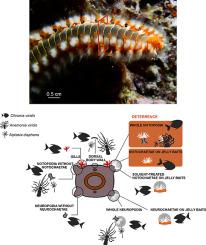当前位置:
X-MOL 学术
›
J. Exp. Mar. Biol. Ecol.
›
论文详情
Our official English website, www.x-mol.net, welcomes your
feedback! (Note: you will need to create a separate account there.)
Synergy between mechanical injury and toxins triggers the urticating system of marine fireworms
Journal of Experimental Marine Biology and Ecology ( IF 1.8 ) Pub Date : 2021-01-01 , DOI: 10.1016/j.jembe.2020.151487 Roberto Simonini , Federica Maggioni , Federica Zanetti , Sergio Fai , Luca Forti , Daniela Prevedelli , Sara Righi
Journal of Experimental Marine Biology and Ecology ( IF 1.8 ) Pub Date : 2021-01-01 , DOI: 10.1016/j.jembe.2020.151487 Roberto Simonini , Federica Maggioni , Federica Zanetti , Sergio Fai , Luca Forti , Daniela Prevedelli , Sara Righi

|
Abstract Marine fireworms (Annelida, Amphinomidae) are notorious for their stinging dorsal bristles (notochaetae). In the large-size species Hermodice carunculata, characterized by invasive potential and great predatory ability, notochaetae deter consumers and damage prey. The origin of fireworm defensive and offensive capacities, the mechanism of action of the stinging chaetae, and whether other chemical defenses occur are still uncertain. In the present study, we tested if the urticating system of fireworms is the result of a synergy between mechanical injury, due to notochaetae penetration, and the release of toxins vehiculated. To determine whether and where chemical or structural deterrents were present, different body parts of H. carunculata involved in inter-specific interactions were assayed (i.e. dorsal body wall, gills, dorsal and ventral parapodia). Feeding bioassays were performed to assess palatability against a fish (generalist consumer) and deterrent action on contact with two sea anemones (fireworm prey). In all the assays, only the offers bearing the dorsal chaetae (notochaetae) strongly deterred consumers and induced paralysis in prey. The notochaetae treated with organic solvents lost their deterrence against fish. Besides, the notopodia were palatable to fish and anemones after the removal of the notochaetae. These findings support a powerful synergy between chemical deterrence and physical structure. To date, the only acute inflammation inducer isolated from an amphinomid is “complanine”, a trimethylammonium compound. High-resolution LC-MS/MS and preliminary NMR analyses suggested the presence of complanine-related compounds in the notochaetae. The present results suggest that the release of compounds and their strong deterrent effect should be mediated by mechanical injury. The sharp, fragile and hollow structure of the notochaetae combined with inflammatory substances could support the success of fireworms in marine benthic environments. Further research is required to ascertain the nature and localization of these chemicals in H. carunculata, broadening knowledge on the chemical ecology of amphinomids.
中文翻译:

机械损伤和毒素的协同作用触发了海洋火虫的荨麻疹系统
摘要 海洋萤火虫(Annelida、Amphinomidae)因其刺背的刚毛(notochaetae)而臭名昭著。在大型物种 Hermodice carunculata 中,具有入侵潜力和强大的捕食能力,棘毛科可威慑消费者并破坏猎物。火虫防御和进攻能力的起源,刺毛毛虫的作用机制以及是否发生其他化学防御仍不确定。在本研究中,我们测试了火虫的荨麻疹系统是否是由于棘毛虫渗透引起的机械损伤与车辆毒素释放之间协同作用的结果。为了确定是否存在化学或结构威慑物以及在何处存在化学或结构威慑物,我们分析了参与种间相互作用的 H. carunculata 的不同身体部位(即背体壁、鳃、背侧和腹侧副足)。进行饲养生物测定以评估对鱼(一般消费者)的适口性和对与两种海葵(火虫猎物)接触的威慑作用。在所有的分析中,只有带有背毛毛纲(notochaetae)的提议才能强烈地阻止消费者并导致猎物瘫痪。用有机溶剂处理过的脊藻失去了对鱼类的威慑力。此外,在去除棘毛纲后,棘足对鱼和海葵来说是可口的。这些发现支持化学威慑和物理结构之间的强大协同作用。迄今为止,从 amphinomid 中分离出的唯一急性炎症诱导剂是“complanine”,一种三甲基铵化合物。高分辨率 LC-MS/MS 和初步 NMR 分析表明,在棘毛纲中存在与紫草碱相关的化合物。目前的结果表明,化合物的释放及其强大的威慑作用应该是由机械损伤介导的。棘毛纲尖锐、脆弱和中空的结构与炎症物质相结合,可以支持火虫在海洋底栖环境中的成功。需要进一步的研究来确定这些化学物质在 H. carunculata 中的性质和定位,从而拓宽对 amphinomids 化学生态学的认识。
更新日期:2021-01-01
中文翻译:

机械损伤和毒素的协同作用触发了海洋火虫的荨麻疹系统
摘要 海洋萤火虫(Annelida、Amphinomidae)因其刺背的刚毛(notochaetae)而臭名昭著。在大型物种 Hermodice carunculata 中,具有入侵潜力和强大的捕食能力,棘毛科可威慑消费者并破坏猎物。火虫防御和进攻能力的起源,刺毛毛虫的作用机制以及是否发生其他化学防御仍不确定。在本研究中,我们测试了火虫的荨麻疹系统是否是由于棘毛虫渗透引起的机械损伤与车辆毒素释放之间协同作用的结果。为了确定是否存在化学或结构威慑物以及在何处存在化学或结构威慑物,我们分析了参与种间相互作用的 H. carunculata 的不同身体部位(即背体壁、鳃、背侧和腹侧副足)。进行饲养生物测定以评估对鱼(一般消费者)的适口性和对与两种海葵(火虫猎物)接触的威慑作用。在所有的分析中,只有带有背毛毛纲(notochaetae)的提议才能强烈地阻止消费者并导致猎物瘫痪。用有机溶剂处理过的脊藻失去了对鱼类的威慑力。此外,在去除棘毛纲后,棘足对鱼和海葵来说是可口的。这些发现支持化学威慑和物理结构之间的强大协同作用。迄今为止,从 amphinomid 中分离出的唯一急性炎症诱导剂是“complanine”,一种三甲基铵化合物。高分辨率 LC-MS/MS 和初步 NMR 分析表明,在棘毛纲中存在与紫草碱相关的化合物。目前的结果表明,化合物的释放及其强大的威慑作用应该是由机械损伤介导的。棘毛纲尖锐、脆弱和中空的结构与炎症物质相结合,可以支持火虫在海洋底栖环境中的成功。需要进一步的研究来确定这些化学物质在 H. carunculata 中的性质和定位,从而拓宽对 amphinomids 化学生态学的认识。











































 京公网安备 11010802027423号
京公网安备 11010802027423号